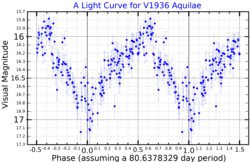Blue supergiant star in the constellation Aquila
V1936 Aquilae is a blue supergiant and candidate Luminous blue variable located in the nebula Westerhout 51 , in the constellation Aquila , about 20,000 light years away. The star was originally identified as a massive star in 2000,[ 3] O-type supergiant . However, subsequent analyses have shown it to be not O but B-type,[ 5] [ 4] variable star by Luboš Kohoutek and R. Wehmeyer in 2004.[ 8]
Properties
V1936 Aquilae is a very luminous star. Recent measurements hint at a bolometric luminosity of around 560,000 L ☉ kiloparsecs , consistent with the distance of Westerhout 51, the very large H II region (nebula) it is located in. The star likely has a temperature of around K [ 5] Stefan-Boltzmann Law suggests a radius of around 143 times that of the Sun .
References
^ "ASAS-SN Variable Stars Database" . ASAS-SN Variable Stars Database . ASAS-SN. Retrieved 6 January 2022 .^ a b c d e Vallenari, A.; et al. (Gaia collaboration) (2023). "Gaia Data Release 3. Summary of the content and survey properties" . Astronomy and Astrophysics . 674 : A1. arXiv :2208.00211 Bibcode :2023A&A...674A...1G . doi :10.1051/0004-6361/202243940 S2CID 244398875 . Gaia DR3 record for this source at VizieR .^ a b Okumura, Shin-ichiro; Mori, Atsushi; Nishihara, Eiji; Watanabe, Etsuji; Yamashita, Takuya (2000-11-01). "The Initial Mass Function of a Massive Star-forming Region W51" . The Astrophysical Journal . 543 (2): 799– 821. Bibcode :2000ApJ...543..799O . doi :10.1086/317116 ISSN 0004-637X . S2CID 120384418 . ^ a b Smith, Nathan; Aghakhanloo, Mojgan; Murphy, Jeremiah W.; Drout, Maria R.; Stassun, Keivan G.; Groh, Jose H. (2019-09-01). "On the Gaia DR2 distances for Galactic luminous blue variables" . Monthly Notices of the Royal Astronomical Society . 488 (2): 1760– 1778. arXiv :1805.03298 Bibcode :2019MNRAS.488.1760S . doi :10.1093/mnras/stz1712 ISSN 0035-8711 . ^ a b c d e f Bik, A.; Henning, Th.; Wu, S. -W.; Zhang, M.; Brandner, W.; Pasquali, A.; Stolte, A. (2019-04-01). "Near-infrared spectroscopy of the massive stellar population of W51: evidence for multi-seeded star formation". Astronomy and Astrophysics . 624 : A63. arXiv :1902.05460 Bibcode :2019A&A...624A..63B . doi :10.1051/0004-6361/201935061 . ISSN 0004-6361 . S2CID 118711844 . ^ Clark, J. S.; Davies, B.; Najarro, F.; MacKenty, J.; Crowther, P. A.; Messineo, M.; Thompson, M. A. (2009). "The P Cygni supergiant [OMN2000] LS1 - implications for the star formation history of W51". Astronomy and Astrophysics . 504 (2): 429. arXiv :0909.3934 Bibcode :2009A&A...504..429C . doi :10.1051/0004-6361/200911980 . S2CID 2609634 . ^ Lim, Wanggi; De Buizer, James M. (2019). "Surveying the Giant H II Regions of the Milky Way with SOFIA. I. W51A" . The Astrophysical Journal . 873 (1): 51. arXiv :1901.07561 Bibcode :2019ApJ...873...51L . doi :10.3847/1538-4357/ab0288 ^ Kohoutek, L.; Wehmeyer, R. (December 2004). "New variable stars among or near to H-alpha emission stars" . Astronomische Nachrichten . 325 (9): 723– 725. Bibcode :2004AN....325..723K . doi :10.1002/asna.200310253 . Retrieved 23 November 2024 .
